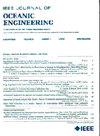Interference Cancellation for UWA Random Access Data Packet Transmission
IF 3.8
2区 工程技术
Q1 ENGINEERING, CIVIL
引用次数: 0
Abstract
In underwater acoustic (UWA) random access communication networks with multiple users and data packet transmissions, the packet collisions are the main cause of the network performance degradation. The aim of this article is to investigate interference cancellation (IC) techniques capable of resolving such collisions in a low-complexity modem with single-carrier modulation and a single transducer. More specifically, in this modem, the IC is used at multiple stages of the receiver. First, the IC is performed for canceling the multipath interference to improve the equalization performance in comparison with the linear equalization and Rake combining. Second, the IC removes the interference from collided data packets within extracted signal segments after identifying the collisions. Finally, the IC is applied to the received baseband signal to improve the data packet detection. Numerical experiments are conducted to investigate the packet detection and decoding performance of the receiver with different channel equalizers. Numerical results indicate that the proposed Rake-IC equalizer provides the best performance among the equalizers considered. The receiver performance is further investigated in a lake experiment with intensive multipath interference. In the experiment, with a channel utilization of 23%, the receiver with the proposed IC techniques reduces the number of lost packets from 33% to 0.26%.UWA随机存取数据包传输的干扰消除
在具有多个用户和数据包传输的水下声学(UWA)随机接入通信网络中,数据包碰撞是网络性能下降的主要原因。本文旨在研究干扰消除(IC)技术,该技术能够在采用单载波调制和单换能器的低复杂度调制解调器中解决此类碰撞问题。更具体地说,在这种调制解调器中,IC 用于接收器的多个阶段。首先,集成电路用于消除多径干扰,与线性均衡和雷克合并相比,提高了均衡性能。其次,在识别碰撞后,集成电路消除提取信号段内碰撞数据包的干扰。最后,集成电路应用于接收到的基带信号,以提高数据包检测能力。我们通过数值实验研究了接收器在使用不同信道均衡器时的数据包检测和解码性能。数值结果表明,在所考虑的均衡器中,建议的 Rake-IC 均衡器性能最佳。在一个具有密集多径干扰的湖泊实验中,对接收器性能进行了进一步研究。在实验中,信道利用率为 23%,采用拟议 IC 技术的接收器将丢失数据包的数量从 33% 降至 0.26%。
本文章由计算机程序翻译,如有差异,请以英文原文为准。
求助全文
约1分钟内获得全文
求助全文
来源期刊

IEEE Journal of Oceanic Engineering
工程技术-工程:大洋
CiteScore
9.60
自引率
12.20%
发文量
86
审稿时长
12 months
期刊介绍:
The IEEE Journal of Oceanic Engineering (ISSN 0364-9059) is the online-only quarterly publication of the IEEE Oceanic Engineering Society (IEEE OES). The scope of the Journal is the field of interest of the IEEE OES, which encompasses all aspects of science, engineering, and technology that address research, development, and operations pertaining to all bodies of water. This includes the creation of new capabilities and technologies from concept design through prototypes, testing, and operational systems to sense, explore, understand, develop, use, and responsibly manage natural resources.
 求助内容:
求助内容: 应助结果提醒方式:
应助结果提醒方式:


